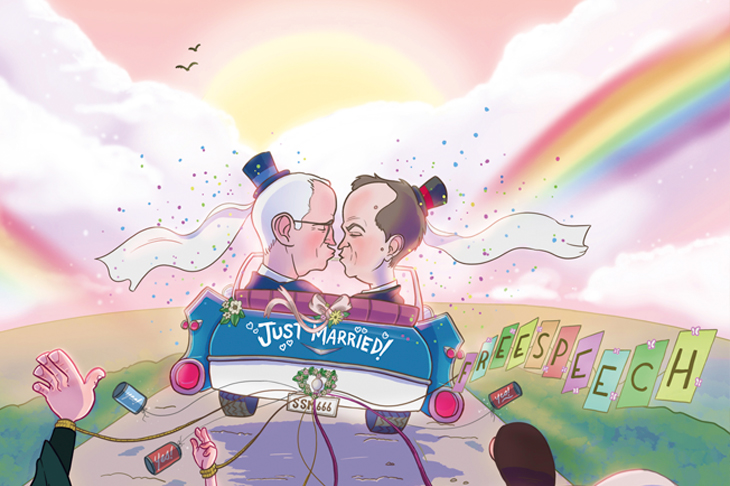The same sex marriage push didn’t just appear overnight. It’s the result of carefully crafted campaigns by US homosexuals with clever marketing techniques to manipulate a naïve public into supporting ‘marriage’ for same sex attracted couples. Branded as ‘equality’ for all, the aim is to upend society as we know it and remake it in their own image.
Its immediate precursor, the so-called ‘Safe’ Schools program, is all part of the package to make the unacceptable acceptable. ‘Safe’ Schools has been the warm-up act before the curtain went up on marriage. But don’t fool yourself that, even if successful, this is the play’s final act. Why give up when you’ve been winning ?
In the first 60 years of the 20th century, both church and state regarded marriage as the foundation stone of civilised society. But gradually Marxist libertarian theories took hold and ‘freedom’, particularly sexual freedom, became the new, trendy and deliciously desirable way to go.
Several forceful and committed identities profited from the new morality and put strategies in place to forward their agendas to change society.
In the early 1950s, Harry Hay was the first to plant the idea that homosexuals, like blacks, were an oppressed minority, using it to pursue the then very radical concept of homosexual ‘rights’. He became a prominent supporter of the infamous pro-paedophilia (NAMBLA) North American Man-Boy Love Association and was considered by many as the ‘father’ of the modern ‘gay’ movement.
Hay was an ‘inspiration’ to Kevin Jennings, a high school teacher in Massachusetts who in 1990 founded the Gay, Lesbian and Straight Education Network (GLSEN). Jennings’ ambition was to indoctrinate children with homosexual ‘education’ through the schools; but he was aware that an overt curriculum would be unacceptable to parents.
‘If the Radical Right can succeed in portraying us as preying on children, we will lose,’ he said. ‘Their language… is laced with subtle and not-so-subtle innuendo that we are “after their kids”.’
In a speech in 1995, he outlined his dilemma and the need for a back door approach to take his agenda into schools in a way that would otherwise have brought condemnation.
Bullying, he claimed, particularly homophobic bullying, begets violence. Schools should be ‘safe’ from bullying of all kinds. Latching onto the ‘safety’ theme, he tapped into a value that everyone has in common: the desire for ‘safety’ is universal, particularly when it concerns children. Anyone opposing this could then be accused of disregarding children’s safety. It was a clever tactic to outwit any coming opposition.
The plan took off a treat, and by 2011 the activists were so emboldened that Daniel Villarreal wrote on Queerty.com: ‘We want our educators to teach future generations of children to accept queer sexuality. In fact, our very future depends on it. Recruiting children? You bet we are.’
Jennings self-promotion was as clever as his ‘safe’ schools strategy. Activist groups flourished, and while careful to keep an oar in mainstream organisations, like suicide prevention, his persistence and organisational skills led to his appointment in the US Education Department overseeing the benign-sounding Safe and Drug Free Schools program. Later appointments in organisations with meaningless names – Be The Change and the Arcus Foundation – promoting anything from social justice to gorillas, easily accommodated Jennings’ proselytising agenda.
Meanwhile, Evan Wolfson had been on the scene since his 1983 Harvard Law School dissertation on homosexual marriage – the beginning of his crusade.
Wolfson’s insight was that although there was no shortage of various outfits all promoting the homosexual agenda, the successes on many fronts – discrimination or AIDS – were piecemeal, and the key to real progress was concentrating on a core theme: his obsession with marriage. His strategy was to bring this into mainstream prominence through ‘individualised conversations’ using the simple language of equality, love and inclusion that everyone would understand. ‘Legalise’ was to be left to the lawyers.
The approach certainly worked with Vice President Joe Biden, won over after a 2012 meeting with a same-sex couple and ‘their’ children. As much as children, adults, particularly politicians, like to be seen as progressive and ‘with it’. Not long after Biden’s meeting, Barack Obama came on board.
Referring to civil unions as ‘the stigma of exclusion’, Wolfson was determined that the word must be marriage. ‘I’m not in this just to change the law’, he wrote, ‘It’s about changing society’. The Freedom to Marry campaign was launched in 2003, and what sounded an absurdity in the 1980s became a reality in 2015 when the US Supreme court declared same-sex marriage protected by the Constitution.
Earlier this year, Wolfson’s Freedom to Marry documentary was shown at Sydney’s Mardi Gras film festival, while it was reported, breathlessly, that Shepparton, Lismore and Kiama would be part of Wolfson’s world tour to ‘boost’ Australia’s campaign. It’s unclear why they were singled out for inclusion and even more unclear if Wolfson ever arrived.
‘It’ll soon be compulsory!’ was once a joke, but today the PC police would be after you in a trice. While the once light, bright and joyful word ‘gay’ has been weighed down with a different meaning, we’ve been conditioned to accept what was once inconceivable – homosexual marriage.
But nothing succeeds like success and sharp, shrewd, cunning and agile minds are planning the next assault on the stable, secure society we once knew. The next manifestation of insanity will continue to have consequences unthought of today.
Got something to add? Join the discussion and comment below.
Get 10 issues for just $10
Subscribe to The Spectator Australia today for the next 10 magazine issues, plus full online access, for just $10.
You might disagree with half of it, but you’ll enjoy reading all of it. Try your first month for free, then just $2 a week for the remainder of your first year.














Comments
Don't miss out
Join the conversation with other Spectator Australia readers. Subscribe to leave a comment.
SUBSCRIBEAlready a subscriber? Log in